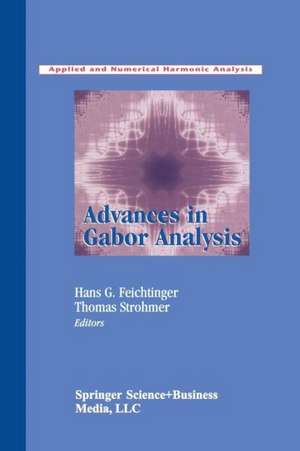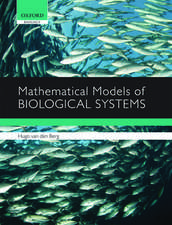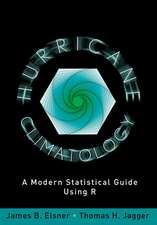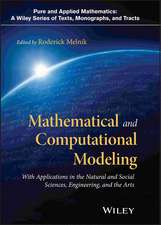Advances in Gabor Analysis: Applied and Numerical Harmonic Analysis
Editat de Hans G. Feichtinger, Thomas Strohmeren Limba Engleză Paperback – 28 oct 2012
| Toate formatele și edițiile | Preț | Express |
|---|---|---|
| Paperback (1) | 644.49 lei 6-8 săpt. | |
| Birkhäuser Boston – 28 oct 2012 | 644.49 lei 6-8 săpt. | |
| Hardback (1) | 650.19 lei 6-8 săpt. | |
| Birkhäuser Boston – 6 dec 2002 | 650.19 lei 6-8 săpt. |
Din seria Applied and Numerical Harmonic Analysis
-
 Preț: 399.29 lei
Preț: 399.29 lei -
 Preț: 310.86 lei
Preț: 310.86 lei - 19%
 Preț: 443.08 lei
Preț: 443.08 lei - 20%
 Preț: 673.02 lei
Preț: 673.02 lei - 17%
 Preț: 431.76 lei
Preț: 431.76 lei -
 Preț: 412.57 lei
Preț: 412.57 lei - 15%
 Preț: 550.04 lei
Preț: 550.04 lei - 15%
 Preț: 653.98 lei
Preț: 653.98 lei - 18%
 Preț: 1014.28 lei
Preț: 1014.28 lei - 15%
 Preț: 647.92 lei
Preț: 647.92 lei -
 Preț: 413.37 lei
Preț: 413.37 lei - 15%
 Preț: 532.89 lei
Preț: 532.89 lei - 15%
 Preț: 646.62 lei
Preț: 646.62 lei - 15%
 Preț: 653.98 lei
Preț: 653.98 lei -
 Preț: 397.38 lei
Preț: 397.38 lei - 15%
 Preț: 656.43 lei
Preț: 656.43 lei - 15%
 Preț: 661.97 lei
Preț: 661.97 lei - 24%
 Preț: 829.71 lei
Preț: 829.71 lei - 18%
 Preț: 957.13 lei
Preț: 957.13 lei - 15%
 Preț: 648.74 lei
Preț: 648.74 lei - 15%
 Preț: 654.77 lei
Preț: 654.77 lei - 15%
 Preț: 636.80 lei
Preț: 636.80 lei -
 Preț: 398.35 lei
Preț: 398.35 lei - 20%
 Preț: 569.85 lei
Preț: 569.85 lei -
 Preț: 392.21 lei
Preț: 392.21 lei - 18%
 Preț: 1121.76 lei
Preț: 1121.76 lei -
 Preț: 387.75 lei
Preț: 387.75 lei - 18%
 Preț: 1006.72 lei
Preț: 1006.72 lei - 20%
 Preț: 567.32 lei
Preț: 567.32 lei - 20%
 Preț: 573.76 lei
Preț: 573.76 lei -
 Preț: 406.80 lei
Preț: 406.80 lei -
 Preț: 387.38 lei
Preț: 387.38 lei - 5%
 Preț: 1168.71 lei
Preț: 1168.71 lei -
 Preț: 400.85 lei
Preț: 400.85 lei -
 Preț: 398.15 lei
Preț: 398.15 lei - 19%
 Preț: 575.82 lei
Preț: 575.82 lei - 15%
 Preț: 703.71 lei
Preț: 703.71 lei - 20%
 Preț: 334.71 lei
Preț: 334.71 lei - 15%
 Preț: 525.54 lei
Preț: 525.54 lei -
 Preț: 405.06 lei
Preț: 405.06 lei - 15%
 Preț: 536.96 lei
Preț: 536.96 lei
Preț: 644.49 lei
Preț vechi: 758.23 lei
-15% Nou
Puncte Express: 967
Preț estimativ în valută:
123.35€ • 127.12$ • 104.14£
123.35€ • 127.12$ • 104.14£
Carte tipărită la comandă
Livrare economică 04-18 martie
Preluare comenzi: 021 569.72.76
Specificații
ISBN-13: 9781461266273
ISBN-10: 1461266270
Pagini: 376
Ilustrații: XIX, 356 p.
Dimensiuni: 155 x 235 x 27 mm
Greutate: 0.53 kg
Ediția:2003
Editura: Birkhäuser Boston
Colecția Birkhäuser
Seria Applied and Numerical Harmonic Analysis
Locul publicării:Boston, MA, United States
ISBN-10: 1461266270
Pagini: 376
Ilustrații: XIX, 356 p.
Dimensiuni: 155 x 235 x 27 mm
Greutate: 0.53 kg
Ediția:2003
Editura: Birkhäuser Boston
Colecția Birkhäuser
Seria Applied and Numerical Harmonic Analysis
Locul publicării:Boston, MA, United States
Public țintă
ResearchCuprins
1 Introduction.- 1.1 Recent Trends in Gabor Analysis.- 1.2 Outline of the Book.- 2 Uncertainty Principles for Time-Frequency Representations.- 2.1 Introduction.- 2.2 The Classical Uncertainty Principle.- 2.3 Time-Frequency Representations.- 2.4 Support Conditions.- 2.5 Essential Support Conditions.- 2.6 Hardy’s Uncertainty Principle.- 2.7 Beurling’s Theorem.- References.- 3 Zak Transforms with Few Zeros and the Tie.- 3.1 Introduction and Announcements of Results.- 3.2 Zak Transforms with Few Zeros.- 3.3 When is (?[0, c0),a, b) a Gabor Frame? “.- References.- 4 Bracket Products for Weyl-Heisenberg Frames.- 4.1 Introduction.- 4.2 Preliminaries.- 4.3 Pointwise Inner Products.- 4.4 a-Orthogonality.- 4.5 a-Factorable Operators.- 4.6 Weyl—Heisenberg Frames and the a-Inner Product.- References.- 5 A First Survey of Gabor Multipliers.- 5.1 Introduction.- 5.2 Notation and Conventions.- 5.3 Basic Theory of Gabor Multipliers.- 5.4 From Upper Symbol to Operator Ideal.- 5.5 Eigenvalue Behavior of Gabor Multipliers.- 5.6 Changing the Ingredients.- 5.7 From Gabor Multipliers to their Upper Symbol.- 5.8 Best Approximation by Gabor Multipliers.- 5.9 STFT-multipliers and Gabor Multipliers.- 5.10 Compactness in Function Spaces.- 5.11 Gabor Multipliers and Time-Varying Filters.- References.- 6 Aspects of Gabor Analysis and Operator Algebras.- 6.1 Introduction.- 6.2 Background.- 6.3 The Density (or Incompleteness) Property.- 6.4 Characterizing the Unique Gabor Dual Property.- 6.5 Gabor Frames for Subspaces.- References.- 7 Integral Operators, Pseudo differential Operators,and Gabor Frames.- 7.1 Introduction.- 7.2 Discussion and Statement of Results.- 7.3 The Modulation Spaces.- 7.4 Invariance Properties of the Modulation Space.- 7.5 Gabor Frames.- 7.6 An Easy Trace-Class Result.-7.7 Finite-Rank Approximations.- 7.8 Improving the Estimate.- 7.9 Conclusion and Observations.- References.- 8 Methods for Approximation of the Inverse (Gabor) Frame Operator.- 8.1 Introduction.- 8.2 The Double Projection Method.- 8.3 Projection Methods for Gabor Frames.- 8.4 On Sampling of Gabor Frames in L2(?).- References.- 9 Wilson Bases on the Interval.- 9.1 Introduction.- 9.2 Wilson Bases of L2(?).- 9.3 Wilson Bases for Periodic Functions.- 9.4 Wilson Bases on the Interval.- 9.5 Algorithms.- References.- 10 Localization Properties and Wavelet-Like Orthonormal Bases for the Lowest Landau Level.- 10.1 Introduction: Phase Space Localization.- 10.2 The Fractional Quantum Hall Effect.- 10.3 A Toy Model.- 10.4 Wavelet Bases for the LLL.- 10.5 Magnetic Translations and Multiresolution Analysis.- 10.6 Conclusion.- 10.7 Appendix: Two Mathematical Tools.- References.- 11 Optimal Stochastic Encoding and Approximation Schemes using Weyl—Heisenberg Sets.- 11.1 Introduction.- 11.2 Stochastic Processes and Statement of the Problems.- 11.3 Semi-optimal and Optimal Solutions.- 11.4 Non-Localization Results.- 11.5 Numerical Examples.- 11.6 Conclusions.- References.- 12 Orthogonal Frequency Division Multiplexing Based on Offset QAM.- 12.1 Introduction and Outline.- 12.2 Orthogonal Frequency Division Multiplexing Based on OQAM.- 12.3 Orthogonality Conditions for OFDM/OQAM Pulse Shaping Filters.- 12.4 Design of OFDM/OQAM Filters.- 12.5 Biorthogonal Frequency Division Multiplexing Based on Offset QAM.- 12.6 Conclusion.- 12.7 Appendix.- References.
Recenzii
"The authors have put their effort into writing articles with the necessary background to make their presentations attractive and including a complete set of references. Good introductions and detailed expositions of ideas are given in all the presentations. These features make this book an invaluable tool for researchers interested in signal analysis. The research community will benefit greatly from this publication." —Mathematical Reviews
"The present book can be considered as a continuation of two previous ones: Gabor Analysis and Algorithms: Theory and Applications, H. G. Feichtinger and T. Strohmer, Eds., Birkhäuser 1998, and the book by K. Gröchenig, Foundations of Time-Frequency Analysis, Birkhäuser 2001. It contains survey chapters, but new results that have not been published previously are also included. The introductory chapter of the book, written by H. G. Feichtinger and T. Strohmer, contains a clear outline of the contents as well as some comments on the future developments in Gabor analysis.
Written by leading experts in the field, the volume appeals, by its interdisciplinary character, to a large audience, both novices and experts, theoretically inclined researchers and practitioners as well. It brilliantly illustrates how application areas and pure and applied mathematics can work together with profit for all." —Revue D'Analyse Numérique et de Théorie de L'Approximation, 2004
"A mathematically sound and self-contained presentation on recent advances in the highly applicable field of Gabor analysis.… This book is a must for all interested in signal analysis, and, of course, in particular in Gabor analysis." —Monatschefte für Mathematik
"The present book can be considered as a continuation of two previous ones: Gabor Analysis and Algorithms: Theory and Applications, H. G. Feichtinger and T. Strohmer, Eds., Birkhäuser 1998, and the book by K. Gröchenig, Foundations of Time-Frequency Analysis, Birkhäuser 2001. It contains survey chapters, but new results that have not been published previously are also included. The introductory chapter of the book, written by H. G. Feichtinger and T. Strohmer, contains a clear outline of the contents as well as some comments on the future developments in Gabor analysis.
Written by leading experts in the field, the volume appeals, by its interdisciplinary character, to a large audience, both novices and experts, theoretically inclined researchers and practitioners as well. It brilliantly illustrates how application areas and pure and applied mathematics can work together with profit for all." —Revue D'Analyse Numérique et de Théorie de L'Approximation, 2004
"A mathematically sound and self-contained presentation on recent advances in the highly applicable field of Gabor analysis.… This book is a must for all interested in signal analysis, and, of course, in particular in Gabor analysis." —Monatschefte für Mathematik













